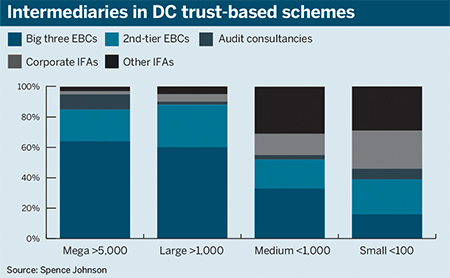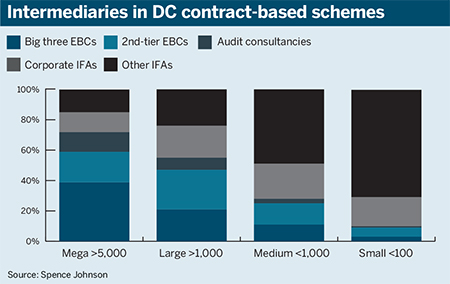SpenceJohnson's Magnus Spence looks at how the advisory market is developing and explains why second-tier firms are gaining ground with defined contribution schemes.
Part of the reason for this shift to second-tier consultants lies in the attraction in dealing with consultants whose businesses are still focused purely on bespoke advisory services
But even more importantly they show how wide the difference is between large and small schemes.
Our latest analysis of the trust-based market suggests that second-tier employee benefit consultants such as Hymans Robertson and LCP have gained market share from the big three consultants among both mega and large defined contribution schemes.

The analysis shows that this share has risen from 16 per cent of mega schemes and 22 per cent of large schemes since this analysis was last conducted, to 21 per cent of mega and 28 per cent of large schemes in this analysis.
Conversations with market participants suggest that part of the reason for this shift lies in the attraction for many large trust-based schemes in dealing with consultants whose businesses are still focused purely on the bespoke advisory services they are most interested in, and who have not ‘diversified’ by rolling out, and indeed trying to ‘upsell’, other DC offerings such as delegated DC, mastertrusts and, to some extent, even asset management services.
In addition, firms such as LCP have had success selling advisory services to schemes in areas outside of investments, including member communications.
Who comes top
The first three consultants in the trust-based market are the obvious ones, ranked in order as: Willis Towers Watson, Mercer and Aon Hewitt.
Intermediaries in the contract-based world tend to be more evenly split among the differently sized schemes.
The most notable change in the latest analysis is in the EBCs’ market share, as both the ‘big three’ EBCs and second-tier EBCs increase their share of the contract-based market.

The second chart looks at the share of each adviser among contract-based schemes. Among mega schemes, EBCs have the biggest share at 60 per cent of mega schemes and 45 per cent of large schemes, up from about 50 per cent and 36 per cent last year.
Why the pension consultancy market is a true oligopoly
From the blog: “Investment consultants have contributed to the poor performance of UK employer-backed pension funds by offering the same advice at the same time,” asserted a recent article in the Financial Times.
This change reflects the extent to which these intermediaries are gaining increasing traction, offering very large group personal pension schemes the same level of intermediary support and servicing that previously was only really available to the trust-based market.
The big three consultants have retained their position as the leading intermediaries to the bundled market when looked at in terms of assets at least. They rank as: Mercer, Aon Hewitt then Willis Towers Watson – so in a different order to that in the trust-based market.
Taken together, these three firms advise just over 15 per cent of assets in the bundled market, an asset share that is almost exactly in line with the one they had last year.
The big three are followed, in this order, by JLT Employee Benefits, Hymans Robertson, LCP, Buck Consultants/Xerox HR Services and then Capita.
Magnus Spence is managing director of Spence Johnson














